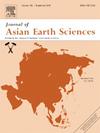印度Pranhita-Godavari盆地古俯冲的证据:来自航磁和重力资料联合解释的约束
IF 2.7
3区 地球科学
Q2 GEOSCIENCES, MULTIDISCIPLINARY
引用次数: 0
摘要
Pranhita-Godavari (PG)盆地是南印度盾中达瓦尔和巴斯塔尔克拉通之间的一个克拉通间断陷盆地。先前的研究表明,它的下面有一个异常厚的地壳,表面热流高,这在克拉通间破裂裂谷盆地中是不常见的特征。为了理解这一罕见现象,我们在地震和地震学资料的约束下,对PG盆地进行了航磁和布格重力资料解释。盆地两侧的布格重力异常高反映了卡里姆纳格尔麻粒岩带和博帕尔帕特南麻粒岩带的地壳伸展。莫霍深度图由受限的三维重力反演得到,显示了该地区35至47公里的深度变化。此外,根据航磁异常资料估计的居里深度在22 ~ 30 km之间变化,盆地下方的深度较浅(~ 22 ~ 26 km),与该地区观测到的较高热流相吻合。地壳模型显示:1)PG盆地下方地壳厚度正常;Ii)盆地内高密度下地壳体(~ 3.05 gm/cc);高密度的中上部地壳体被解释为粒状岩石(KGB和BGB),在PG盆地边缘表现出增强的磁化。克格勃和BGB在PG盆地下都随着深度的增加而变厚,然后迅速变薄——类似于盆地沉积中心下的边界。克格勃和BGB都代表了一个连续的麻粒岩包。麻粒岩包体的减薄与裂谷形成和PG盆地发育相关的地壳减薄有关。本文章由计算机程序翻译,如有差异,请以英文原文为准。
Evidence of Paleo-Subduction along the Pranhita-Godavari Basin, India: Constraints from the joint interpretation of aeromagnetic and gravity data
Pranhita-Godavari (PG) Basin is an inter-cratonic failed rift basin between the Dharwar and Bastar cratons in the Southern Indian Shield. Previous studies reveal an unusually thick crust beneath it with high surface heat flow, a characteristic uncommon in inter-cratonic failed rift basins. To understand this uncommon phenomena, we carry out the aeromagnetic and Bouguer gravity data interpretation of the PG Basin constrained by seismic and seismological data. The Bouguer gravity anomaly highs on either side of the basin reflect crustal extension of the Karimnagar Granulite Belt (KGB) and Bhopalpatnam Granulite Belt (BGB). The Moho depth map, derived from constrained 3-D gravity inversion, shows depth variations between 35 and 47 km in the region. Additionally, the estimated Curie depths from aeromagnetic anomaly data vary between 22 and 30 km, with shallower depths (∼22–26 km) beneath the basin, and reconcile with the observed higher heat flow in the region. The crustal model reveals: i) a normal crustal thickness below the PG Basin; ii) a high-density lower crustal body (∼3.05 gm/cc) within the basin; iii) high-density, upper-mid crustal bodies interpreted as granulitic rocks (KGB and BGB) exhibit increased magnetisation at the margins of the PG basin. Both the KGB and BGB thicken with depth beneath the PG Basin before rapidly thinning-resembling boudinage beneath the basin depocenter. Both KGB and BGB represent once continuous package of granulite rocks. The thinning of granulite package is related to crustal thinning associated with rift formation and the development of PG Basin.
求助全文
通过发布文献求助,成功后即可免费获取论文全文。
去求助
来源期刊

Journal of Asian Earth Sciences
地学-地球科学综合
CiteScore
5.90
自引率
10.00%
发文量
324
审稿时长
71 days
期刊介绍:
Journal of Asian Earth Sciences has an open access mirror journal Journal of Asian Earth Sciences: X, sharing the same aims and scope, editorial team, submission system and rigorous peer review.
The Journal of Asian Earth Sciences is an international interdisciplinary journal devoted to all aspects of research related to the solid Earth Sciences of Asia. The Journal publishes high quality, peer-reviewed scientific papers on the regional geology, tectonics, geochemistry and geophysics of Asia. It will be devoted primarily to research papers but short communications relating to new developments of broad interest, reviews and book reviews will also be included. Papers must have international appeal and should present work of more than local significance.
The scope includes deep processes of the Asian continent and its adjacent oceans; seismology and earthquakes; orogeny, magmatism, metamorphism and volcanism; growth, deformation and destruction of the Asian crust; crust-mantle interaction; evolution of life (early life, biostratigraphy, biogeography and mass-extinction); fluids, fluxes and reservoirs of mineral and energy resources; surface processes (weathering, erosion, transport and deposition of sediments) and resulting geomorphology; and the response of the Earth to global climate change as viewed within the Asian continent and surrounding oceans.
 求助内容:
求助内容: 应助结果提醒方式:
应助结果提醒方式:


